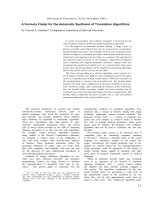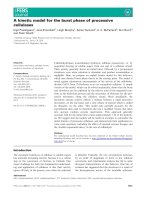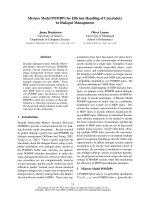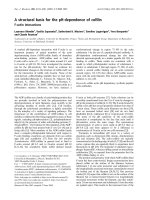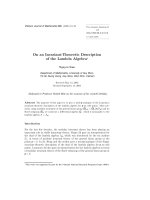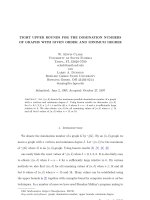Báo cáo toán học: "On an identity for the cycle indices of rooted tree automorphism groups" doc
Bạn đang xem bản rút gọn của tài liệu. Xem và tải ngay bản đầy đủ của tài liệu tại đây (103.83 KB, 7 trang )
On an identity for the cycle indices of rooted tree
automorphism groups
Stephan G. Wagner
∗
Institut f¨ur Analysis und Computational Number Theory
Technische Universit¨at Graz
Steyrergasse 30, 8010 Graz, Austria
Submitted: Jul 25, 2006; Accepted: Sep 15, 2006; Published: Sep 22, 2006
Mathematics Subject Classifications: 05A15,05A19,05C30
Abstract
This note deals with a formula due to G. Labelle for the summed cycle indices
of all rooted trees, which resembles the well-known formula for the cycle index of
the symmetric group in some way. An elementary proof is provided as well as
some immediate corollaries and applications, in particular a new application to
the enumeration of k-decomposable trees. A tree is called k-decomposable in this
context if it has a spanning forest whose components are all of size k.
1 Introduction
P´olya’s enumeration method is widely used for graph enumeration problems – we refer to
[6] and the references therein for instance. For the application of this method, information
on the cycle indices of certain groups is needed – mostly, these are comparatively simple
examples, such as the cyclic group, the dihedral group or the symmetric group. A very
well-known formula gives the cycle index of the symmetric group S
n
(we adopt the notation
from [6] here):
Z(S
n
) =
j
1
+2j
2
+ +nj
n
=n
n
k=1
s
j
k
k
k
j
k
j
k
!
. (1)
One has
∞
n=0
Z(S
n
)t
n
= exp
∞
k=1
s
k
k
t
k
,
an identity which is of importance in various tree counting problems (cf. again [6]).
∗
The author is supported by project S9611 of the Austrian Science Foundation FWF
the electronic journal of combinatorics 13 (2006), #N14 1
In the past, several tree counting problems related to the automorphism groups of
trees have been investigated. We state, for instance, the enumeration of identity trees
(see [7]), and the question of determining the average size of the automorphism group in
certain classes of trees (see [9, 10]).
Therefore, it is not surprising that so-called cycle index series or indicatrix series [2, 8]
are of interest in enumeration problems. Given a combinatorial species F , the indicatrix
series is given by
Z
F
(s
1
, s
2
, . . .) =
c
1
+2c
2
+3c
3
+ <∞
f
c
1
,c
2
,c
3
,
s
c
1
1
s
c
2
2
s
c
3
3
. . .
1
c
1
c
1
!2
c
2
c
2
!3
c
3
c
3
! . . .
,
where f
c
1
,c
2
,c
3
,
denotes the number of F -structures on n = c
1
+ 2c
2
+ 3c
3
+ . . . points
which are invariant under the action of any (given) permutation σ of these n points with
cycle type (c
1
, c
2
, . . .) (i.e. exactly c
k
cycles of length k). See for instance [2, 6, 8] and
the references therein for more information on cycle index series. Equivalently, it can be
defined via
Z
F
(s
1
, s
2
, . . .) =
n≥0
1
n!
σ∈S
n
fix F[σ]x
σ
1
1
x
σ
2
2
x
σ
3
3
. . .
,
where fix F [σ] is the number of F -structures for which the permutation σ is an automor-
phism and (σ
1
, σ
2
, . . .) is the cycle type of σ [2].
In this note, we deal with the special family T of rooted trees. Yet another reformu-
lation shows that the cycle index series is also
T ∈T
Z(Aut(T )),
where Z(Aut(T )) is the cycle index of the automorphism group of T . The following
formula for the cycle index series is due to G. Labelle [8, Corollary A2]:
Theorem 1 The cycle index series for rooted trees is given by
Z
T
(s
1
, s
2
, . . .) =
c
1
>0
c
2
,c
3
, ≥0
c
c
1
−1
1
s
c
1
1
c
1
!
i>1
1
c
i
!i
c
i
j|i
jc
j
c
i
−1
j|i,j=i
jc
j
s
c
i
i
.
Note that the expression resembles (1), though it is somewhat longer. This result seems
to be not too well-known, but it certainly deserves attention. In [8], Labelle proves it in
a more general setting, using a multidimensional version of Lagrange’s inversion formula
due to Good [4]. On the other hand, Constantineau and J. Labelle provide a combinatorial
proof in [3].
First of all, we will give a simple proof (though, of course, less general than Labelle’s)
for this formula, for which only the classical single-variable form of Lagrange inversion will
be necessary; then, some immediate corrolaries are stated. Finally, the use of the cycle
index series is demonstrated by applying the formula to the enumeration of weighted trees
and k-decomposable trees.
the electronic journal of combinatorics 13 (2006), #N14 2
2 Proof of the main theorem
By the recursive structure of rooted trees and the multiplicative properties of the cycle
index, it is not difficult to see that Z = Z
T
(s
1
, s
2
, . . .) satisfies the relation
Z = s
1
exp
m≥1
1
m
Z
m
,
which is given, for instance, in a paper of Robinson [12, p. 344] and the book of Bergeron
et al. [2, p. 167]. Here, Z
m
is obtained from Z by replacing every s
i
with s
mi
. Now, we
prove the following by induction on k:
Z =
c
1
, ,c
k
≥0
c
1
>0
c
c
1
−1
1
s
c
1
1
c
1
!
k
i=2
1
c
i
!i
c
i
j|i
jc
j
c
i
−1
j|i,j=i
jc
j
s
c
i
i
exp
m>k
1
m
d|m,d≤k
dc
d
Z
m
in the ring of formal power series. Then, for finite k, the coefficient of s
c
1
1
. . . s
c
k
k
follows
at once, since
m>k
1
m
d|m,d≤k
dc
d
Z
m
doesn’t contain the variables s
1
, . . . , s
k
.
First note that, by Lagrange’s inversion formula (cf. [5, 6]), we have
w =
c≥1
c
c−1
c!
x
c
and
exp(aw) =
c≥0
a(c + a)
c−1
c!
x
c
if w = xe
w
. This yields
Z = s
1
exp
Z +
m≥2
1
m
Z
m
=
c
1
≥1
c
c
1
−1
1
c
1
!
s
c
1
1
exp
m≥2
c
1
m
Z
m
,
which is exactly the desired formula for k = 1. For the induction step, we note that
Z
l
= s
l
exp
m≥1
1
m
Z
ml
the electronic journal of combinatorics 13 (2006), #N14 3
and thus, by the induction hypothesis,
Z =
c
1
, ,c
k−1
≥0
c
1
>0
c
c
1
−1
1
s
c
1
1
c
1
!
k−1
i=2
1
c
i
!i
c
i
j|i
jc
j
c
i
−1
j|i,j=i
jc
j
s
c
i
i
exp
1
k
d|k,d=k
dc
d
Z
k
+
m>k
1
m
d|m,d<k
dc
d
Z
m
=
c
1
, ,c
k−1
≥0
c
1
>0
c
c
1
−1
1
s
c
1
1
c
1
!
k−1
i=2
1
c
i
!i
c
i
j|i
jc
j
c
i
−1
j|i,j=i
jc
j
s
c
i
i
c
k
≥0
1
c
k
! · k
j|k,j=k
jc
j
c
k
+
1
k
j|k,j=k
jc
j
c
k
−1
s
c
k
k
exp
l>1
kc
k
kl
Z
kl
exp
m>k
1
m
d|m,d<k
dc
d
Z
m
=
c
1
, ,c
k
≥0
c
1
>0
c
c
1
−1
1
s
c
1
1
c
1
!
k
i=2
1
c
i
!i
c
i
j|i
jc
j
c
i
−1
j|i,j=i
jc
j
s
c
i
i
exp
m>k
1
m
d|m,d≤k
dc
d
Z
m
.
This finishes the induction.
Corollary 2 The number t
n
= |T
n
| of rooted trees on n vertices is given by
t
n
=
c
1
+2c
2
+ =n
c
1
>0
c
c
1
−1
1
c
1
!
i>1
1
c
i
!i
c
i
j|i
jc
j
c
i
−1
j|i,j=i
jc
j
.
Proof: Simply set s
1
= s
2
= . . . = 1 in the identity
T ∈T
n
Z(Aut(T )) =
c
1
+2c
2
+ =n
c
1
>0
c
c
1
−1
1
s
c
1
1
c
1
!
i>1
1
c
i
!i
c
i
j|i
jc
j
c
i
−1
j|i,j=i
jc
j
s
c
i
i
.
As a second corollary, we obtain Cayley’s formula for the number of rooted labeled
trees.
Corollary 3 The number of rooted labeled trees on n vertices is given by n
n−1
.
the electronic journal of combinatorics 13 (2006), #N14 4
Proof: Note that the coefficient of s
n
1
in the cycle index of a rooted tree T on n vertices
is precisely | Aut(T )|
−1
. Thus, we have
T ∈T
n
| Aut(T )|
−1
=
n
n−1
n!
.
But
n!
| Aut T |
is exactly the number of different labelings of T , which finishes the proof.
3 Further applications
Theorem 1 can also be applied to a general class of enumeration problems: let a set B
of combinatorial objects with an additive weight be given, and let B(z) be its counting
series. Now, if we want to enumerate trees on n vertices, where an element of B is assigned
to every vertex of the tree, the counting series is given by
c
1
+2c
2
+ =n
c
1
>0
c
c
1
−1
1
c
1
!
B(z)
c
1
i>1
1
c
i
!i
c
i
j|i
jc
j
c
i
−1
j|i,j=i
jc
j
B(z
i
)
c
i
.
The coefficient of z equals the total weight. For example, the counting series for rooted
weighted trees on n vertices (i.e. each vertex is assigned a positive integer weight, cf.
Harary and Prins [7]) is given by
W (z) =
c
1
+2c
2
+ =n
c
1
>0
c
c
1
−1
1
c
1
!
z
1 − z
c
1
i>1
1
c
i
!i
c
i
j|i
jc
j
c
i
−1
j|i,j=i
jc
j
z
i
1 − z
i
c
i
.
The first few instances are
• n = 1: W (z) =
z
1−z
= z + z
2
+ z
3
+ . . .,
• n = 2: W (z) =
z
2
(1−z)
2
= z
2
+ 2z
3
+ 3z
4
+ . . .,
• n = 3: W (z) =
z
3
(2+z)
(1−z)
2
(1−z
2
)
= 2z
3
+ 5z
4
+ 10z
5
+ . .
Finally, we are going to consider a new application of Theorem 1. This example deals with
the decomposability of trees: we call a tree k-decomposable (a special case of the general
concept of λ-decomposability, see [1, 16]) if it has a spanning forest whose components
are all of size k. It has been shown by Zelinka [17] that such a decomposition, if it
exists, is always unique. The special case k = 2, which has already been investigated
by Moon [11] and Simion [13, 14], corresponds to perfect matchings. Now, let D(x)
denote the generating function for the number of k-decomposable rooted trees. Since a
decomposable rooted tree is made up from a rooted tree on k vertices (the component
the electronic journal of combinatorics 13 (2006), #N14 5
containing the root) and collections of k-decomposable rooted trees attached to each of
these k vertices, we obtain the following functional equation for k-decomposable trees:
D(x) =
c
1
+2c
2
+ =k
c
1
>0
c
c
1
−1
1
c
1
!
E(x)
c
1
i>1
1
c
i
!i
c
i
j|i
jc
j
c
i
−1
j|i,j=i
jc
j
E(x
i
)
c
i
,
where E(x) = x exp
m≥1
1
m
D(x
m
)
. For k = 2, we obtain
D(x) = x
2
exp
m≥1
2
m
D(x
m
)
,
giving the known counting series for trees with a perfect matching (Sloane’s A000151 [15],
see also [11, 13, 14]):
D(x) = x
2
+ 2x
4
+ 7x
6
+ 26x
8
+ 107x
10
+ 458x
12
+ . . .
For k = 3, to give a new example, we have
D(x) =
3x
3
2
exp
m≥1
3
m
D(x
m
)
+
x
3
2
exp
m≥1
1
m
D(x
m
) + D(x
2m
)
,
yielding
D(x) = 2x
3
+ 10x
6
+ 84x
9
+ 788x
12
+ . . .
Of course, it is possible to calculate the counting series of k-decomposable rooted trees for
arbitrary k in this way. The functional equation can also be used to obtain information
about the asymptotic behavior (cf. [6, 16]).
Acknowledgment
The author is highly indebted to an anonymous referee for providing him with a lot of
valuable information, in particular references [2, 3, 4, 8, 12].
References
[1] D. Barth, O. Baudon, and J. Puech. Decomposable trees: a polynomial algorithm
for tripodes. Discrete Appl. Math., 119(3):205–216, 2002.
[2] F. Bergeron, G. Labelle, and P. Leroux. Combinatorial species and tree-like struc-
tures, volume 67 of Encyclopedia of Mathematics and its Applications. Cambridge
University Press, Cambridge, 1998.
the electronic journal of combinatorics 13 (2006), #N14 6
[3] I. Constantineau and J. Labelle. Calcul combinatoire du nombre d’endofonctions et
d’arborescences laiss´ees fixes par une permutation. Ann. Sci. Math. Qu´ebec, 13(2):33–
38, 1990.
[4] I. J. Good. Generalizations to several variables of Lagrange’s expansion, with appli-
cations to stochastic processes. Proc. Cambridge Philos. Soc., 56:367–380, 1960.
[5] I. P. Goulden and D. M. Jackson. Combinatorial enumeration. A Wiley-Interscience
Publication. John Wiley & Sons Inc., New York, 1983. Wiley-Interscience Series in
Discrete Mathematics.
[6] F. Harary and E. M. Palmer. Graphical enumeration. Academic Press, New York,
1973.
[7] F. Harary and G. Prins. The number of homeomorphically irreducible trees, and
other species. Acta Math., 101:141–162, 1959.
[8] G. Labelle. Some new computational methods in the theory of species. In Com-
binatoire ´enum´erative (Montreal, Que., 1985/Quebec, Que., 1985), volume 1234 of
Lecture Notes in Math., pages 192–209. Springer, Berlin, 1986.
[9] K. A. McKeon. The expected number of symmetries in locally-restricted trees. I.
In Graph theory, combinatorics, and applications. Vol. 2 (Kalamazoo, MI, 1988),
Wiley-Intersci. Publ., pages 849–860. Wiley, New York, 1991.
[10] K. A. McKeon. The expected number of symmetries in locally restricted trees. II.
Discrete Appl. Math., 66(3):245–253, 1996.
[11] J. W. Moon. The number of trees with a 1-factor. Discrete Math., 63(1):27–37, 1987.
[12] R. W. Robinson. Enumeration of non-separable graphs. J. Combinatorial Theory,
9:327–356, 1970.
[13] R. Simion. Trees with a 1-factor: degree distribution. In Proceedings of the fif-
teenth Southeastern conference on combinatorics, graph theory and computing (Baton
Rouge, La., 1984), volume 45, pages 147–159, 1984.
[14] R. Simion. Trees with 1-factors and oriented trees. Discrete Math., 88(1):93–104,
1991.
[15] N. J. A. Sloane. The On-Line Encyclopedia of Integer Sequences. Published elec-
tronically at />[16] S. Wagner. On the number of decomposable trees. In Proceedings of the Fourth
Colloquium on Mathematics and Computer Science (Nancy 2006), pages 301-308,
2006.
[17] B. Zelinka. Partitionability of trees. Czechoslovak Math. J., 38(113)(4):677–681,
1988.
the electronic journal of combinatorics 13 (2006), #N14 7
